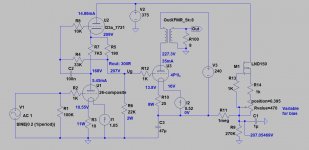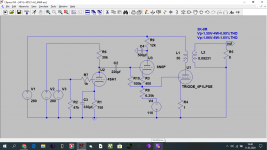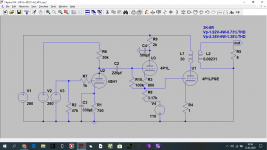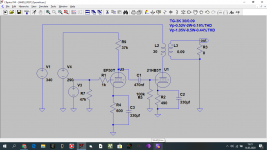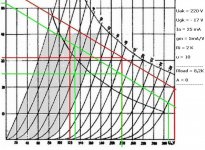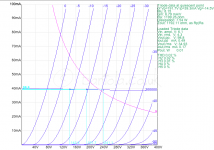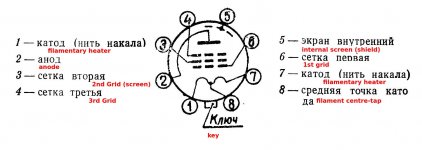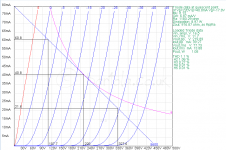Right now I have 45 tube with regular bypass cap and resistor, maybe it will be better with fixed bias, but I dont know.... As a driver I use 6N23P SRPP (same driver as I used with 4P1L dc coupled amp) which is capacitor coupled to the 45. Maybe its the bypass cap or the driver distorting (it must generate twice output voltage now) which is wrong.
Ive got two KC1 telefunken tube (dht with amplification of 30), and I can try it as a driver to drive 4P1L....
And trust me, DC coupled sounded (with 4P1L) really good even with the bypass cathode cap.
but I want to test something really different: using a voltage regulator tube instead of the cathode resistor and cap!
Would be happy if you could show your 4p1L DC couple schematic.
I have both the 4p1L with filament bias to compare with my DC coupled 45 with ultrapath. They both are good with merits in different materials I fed into them.
Would be happy if you could show your 4p1L DC couple schematic.
I have both the 4p1L with filament bias to compare with my DC coupled 45 with ultrapath. They both are good with merits in different materials I fed into them.
Here it is, the voltages are not 100% the same, each DC coupled amp you must tweak individually. I hope you can read the image.
An externally hosted image should be here but it was not working when we last tested it.
Here it is, the voltages are not 100% the same, each DC coupled amp you must tweak individually. I hope you can read the image.

Would you kind enough to show it in PDF file. I can't open this file.
Thanks
https://hosting.photobucket.com/images/i/michalkupec54/0/email.seznam.cz.jpgWould you kind enough to show it in PDF file. I can't open this file.
Thanks
i hope this link will work
https://hosting.photobucket.com/images/i/michalkupec54/0/email.seznam.cz.jpg
i hope this link will work
Big thanks
This is the best amp that I have built. Ive played with the current through the driver tubes.Big thanks
Like 4mA in the schematic: the sound is open, fradgile and very detailed, but not much bass. Instrument separation is very good.
Then I replaced lower resistor with an LED and upper cathode resistor recalculated to have same parametres as the LED. I changed also the dropping resistor from cca 33K to 11K.
The tube has 14mA current or so.
With this configuration it has more drive and the bass is punchier and heavier. But it seems less clean overall. But still pretty good. You must play with the current and to the driver position use double triode which can work at low voltages of 80-100V (with normal bias point and current). ECC88 or 6N23P are pretty suitable for this, but if you will know any other tube which works with these voltages fine, let me know.
Sounds good and I am going to check what parts and tubes I have I hand. You make me busy again.This is the best amp that I have built. Ive played with the current through the driver tubes.
Like 4mA in the schematic: the sound is open, fradgile and very detailed, but not much bass. Instrument separation is very good.
Then I replaced lower resistor with an LED and upper cathode resistor recalculated to have same parametres as the LED. I changed also the dropping resistor from cca 33K to 11K.
The tube has 14mA current or so.
With this configuration it has more drive and the bass is punchier and heavier. But it seems less clean overall. But still pretty good. You must play with the current and to the driver position use double triode which can work at low voltages of 80-100V (with normal bias point and current). ECC88 or 6N23P are pretty suitable for this, but if you will know any other tube which works with these voltages fine, let me know.
Sounds good and I am going to check what parts and tubes I have in hand. You make me busy again.This is the best amp that I have built. Ive played with the current through the driver tubes.
Like 4mA in the schematic: the sound is open, fradgile and very detailed, but not much bass. Instrument separation is very good.
Then I replaced lower resistor with an LED and upper cathode resistor recalculated to have same parametres as the LED. I changed also the dropping resistor from cca 33K to 11K.
The tube has 14mA current or so.
With this configuration it has more drive and the bass is punchier and heavier. But it seems less clean overall. But still pretty good. You must play with the current and to the driver position use double triode which can work at low voltages of 80-100V (with normal bias point and current). ECC88 or 6N23P are pretty suitable for this, but if you will know any other tube which works with these voltages fine, let me know.
Concept:
#26, D3a as gyrator, DC coupled 4P1L SE (5k:8).
The 4P1L PSU is floating, all voltage here (power tube) is reference to this PSU's "ground".
Good 1W in A1 region.
Push 4P1L to A2 theoretically reaches 2W (5%).
#26, D3a as gyrator, DC coupled 4P1L SE (5k:8).
The 4P1L PSU is floating, all voltage here (power tube) is reference to this PSU's "ground".
Good 1W in A1 region.
Push 4P1L to A2 theoretically reaches 2W (5%).
Attachments
Last edited:
2.4w practically, with cathode follower drive as in the initial post #1
Roughly 5w from a paralleled pair.
1.8w in A1
Roughly 5w from a paralleled pair.
1.8w in A1
I'm looking for 4P1L datasheet in English please.
TIA
Felipe
Please help?
Please help?
What do you want Felipe?
All information is available on internet.
4P1L | Tubes Information
4P1L – Bartola(R) Valves
p.s.
"The Bible says that if you give a man a fish, he will eat today, but teach a man to fish and he will eat forever. " 🙂
Attachments
Last edited:
Sorry I am not sure if this is help full, but previous advice for this type of problem is to copy text from pdf into Google translate, which I cannot do on my phone.Please help?
But
Try these links, which have a bit more information :
Tube Tester Files - 4P1L
Russian-English Translation of 4P1L datasheet
Regards
Grant
- Home
- Amplifiers
- Tubes / Valves
- One more 4P1L SE
